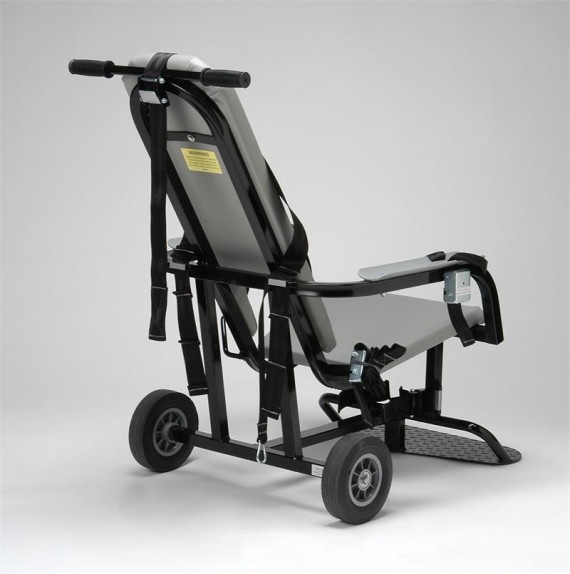
Restraint Chair Similar To One Used At Jail
A 27 year-old man, who we will call Charles, was trying to kill himself when workers at the Northern Virginia Mental Health Institute in Falls Church intervened. He began hitting them. The state police were called and Charles was taken from the residential treatment center to the jail, charged with five counts of misdemeanor simple assault.
This is the same Fairfax detention center where Natasha McKenna, a 37 year-old woman with schizophrenia died after being shot with a 50,000 volt taser four times while in shackles with her head hooded.
Charles was booked into jail on April 28th. He had a long history of suicide attempts.
Two days later, April 30th, Charles began hitting his head against the cell wall. He was put into a padded cell and then strapped into a restraint chair.
On May 1st, deputies decided he was calm enough to move him into a single cell, but Charles began threatening suicide and so on May 2nd, he was put back in the restraint chair. On May 3rd, he was calm enough to return to his cell.
On May 5th, seven days after he was booked into the jail, mental health workers at the jail asked a judge to approve an order sending Charles to the Western State Hospital in Staunton, Virginia for treatment. The judge issued the order but when the jail contacted the state hospital, its intake staff refused to accept Charles as a patient. They told deputies to take Charles to Central State Hospital in Petersburg, Virginia.
On May 6th, the judge agreed to amend his court order so that deputies could transport Charles to Central State Hospital, but within an hour that same day, intake workers at Central State informed the jail that they would not accept Charles as a patient.
Central State workers told the jail to return Charles back to the Northern Virginia Mental Health Institute where he first got into trouble, which is where they took him.
The result: Charles now faces criminal charges, he spent hours in a restraint chair, which has been described as pure torture by those who have been confined in them, and after seven days, he ended up back in the same state institution where he had initially attempted to kill himself.
Case Two: Carol
Carol is a 47 year-old woman who refused to leave Reston Hospital after she was discharged. When the Fairfax Police arrived, she informed them that she was the CEO and owner of the Reston Hospital and that President Barrack Obama would strip them of their badges if they tried to forcibly remove her. She explained that she had an executive suite in the hospital where her personal chef prepared meals for her.
Because she refused to leave, the police arrested her for misdemeanor trespassing and took her to jail where an intake officer noted: “Inmate is Bi-polar, border line schizophrenic, has a ruptured disk and a broken foot.” The woman, who we will call Carol, refused to take her medication.
Carol was booked into the jail April 21. Two days later, she flooded her cell and smeared feces on herself. She refused to comply when deputies asked her to let a nurse take her vital signs. Deputies cleaned her cell.
On April 26th, Carol agreed to allow the medical staff to check her vital signs and they discovered she was dehydrated.
On April 27th, Carol stopped eating and drinking.
On April 28th, Carol began dunking her hair and head into the toilet and banging it against the porcelain base. Deputies put her into a restraint chair. After two hours, she was calm enough to be released.
On April 30th, Carol refused to answer questions and comply with orders. She told deputies that she was president of the U.S.
On May 1st, jail officials met with the Commonwealth Attorney and suggested that the trespassing charge be dismissed so that Carol could be released, but the attorney refused. Instead it was decided that Carol would remained charged with trespassing but would be allowed to sign a personal recognizance bond. She was then taken by deputies, under an emergency commitment order, to a Virginia hospital (not Reston) where she was held to await an involuntary commitment hearing before an administrative law judge.
The two cases that I have described happened in Fairfax County where I live, but they are typical of incidents that occur every day in our country. Unfortunately, the public often believes that persons with mental illnesses, who are arrested, are violent criminals who need to be jailed. They do not realize that jails have become dumping grounds and that deputies often are put into untenable situations. Often, these incidents end tragically.
The recent death of Natasha McKenna has alarmed Fairfax County residents, but what happened to her inside the jail is only a piece of a larger puzzle. She should have never been booked into the detention facility.
Did sending Charles to jail at taxpayer expense accomplish anything? (It costs roughly $145 per day in Fairfax to house an inmate in the detention center.)
What good did arresting Carol achieve?
Now imagine if Charles was your son, your brother, your father, or your friend.
Imagine if Carol was your daughter, your sister, your mother or your friend.



